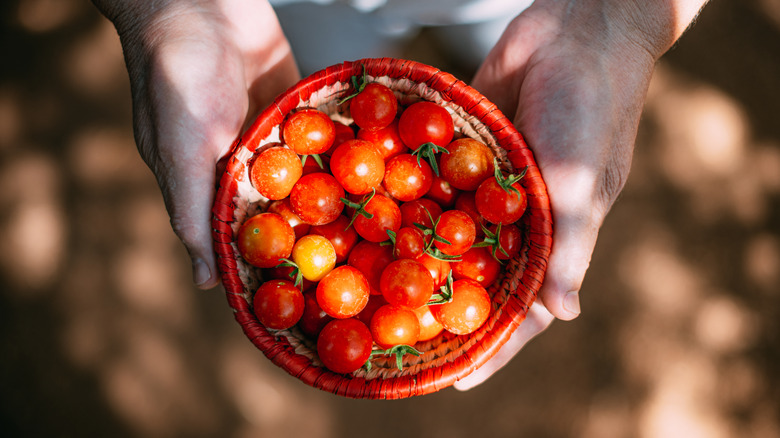Is There Really Any Difference Between Cherry And Grape Tomatoes?
Sweet, juicy, and vibrant, fresh tomatoes are a highlight of the summer season. From Roma to San Marzano, there are over 10,000 varieties to choose from. Each has a unique flavor that makes it stand apart, so it's important to know the differences. For example, let's dig into two of the most popular types that are commonly mistaken for each other: Cherry and grape tomatoes.
While these tiny tomatoes share a few characteristics (aside from their fruit-inspired names) they are far from the same. For one, cherry tomatoes are much smaller and rounder than grape tomatoes, which are more oblong in shape. (And if you're curious, yes, they do get their titles from their signature shapes.) Cherry tomatoes are soft and squishy in texture and burst in your mouth as you bite in, while grape tomatoes are much meatier and chewier with less juiciness. Texture aside, a grape tomato's thicker skin also means that it has a longer shelf lifethan a cherry tomato. (But if you want to extend any tomato's lifespan, you can always try out some best kept secrets for fresh tomato storage.) Finally, cherry tomatoes have a much sweeter and crisper flavor profile than grape tomatoes, which have a flavor that tends to vary per batch but is often said to be rich and balanced.
What cherry and grape tomatoes have in common
If you've been using the names for grape and cherry tomatoes interchangeably, it's due time to stop. Still, the mixup is pretty understandable because, while there's much that sets these veggies apart, there's plenty that they share, too. For starters, while cherry tomatoes originate from South America and grape tomatoes come from Southeast Asia, both varieties are now cultivated world-wide. Additionally, these tomatoes are available year-round, so they're a great staple vegetable to keep on hand in the kitchen. Both are rich in the same essential vitamins like A and C, and they come in many other colors besides red such as pink, brown, orange, and green, to name a few. (So don't automatically write off a brown tomato as a red flag when shopping for produce at the store.)
So even though there's a lot that sets these tomatoes apart, there's dozens of qualities they have in common too. This makes things really convenient when it comes time to decide which variety to incorporate into your next recipe.
The versatility of these tiny tomatoes
Because grape and cherry tomatoes share many of the same characteristics, you can usually use them interchangeably in most recipes. Still, due to their unique taste and textures, you might want to pick one over the other for your dish of choice based on personal preference. For example, if you are making a recipe where you expect to have leftovers, grape tomatoes might be a better choice because they last longer. Alternatively, if you want a sweeter bite to your dish, cherry might be a better option.
The bright burst of flavor tomatoes provide makes them a great addition to summer snacks and salads tossed with some balsamic or vinaigrette dressing. You can toss them in the bowl raw, or, to further boost the flavor of your tomatoes, you can even roast them so they soften up and unleash their inner juices. Roasted tomatoes take on an especially rich, umami flavor as they heat, which makes for an addictive savory flavor. Pair your tomatoes with chicken or steak for some savory kebabs, or puree them with some oils and spices to make a savory pasta or pizza sauce. At the end of the day, what tomato you use and how is up to you. Even if they're not entirely one and the same, both grape and cherry tomatoes can bring vibrant color and flavor to your favorite dishes.


